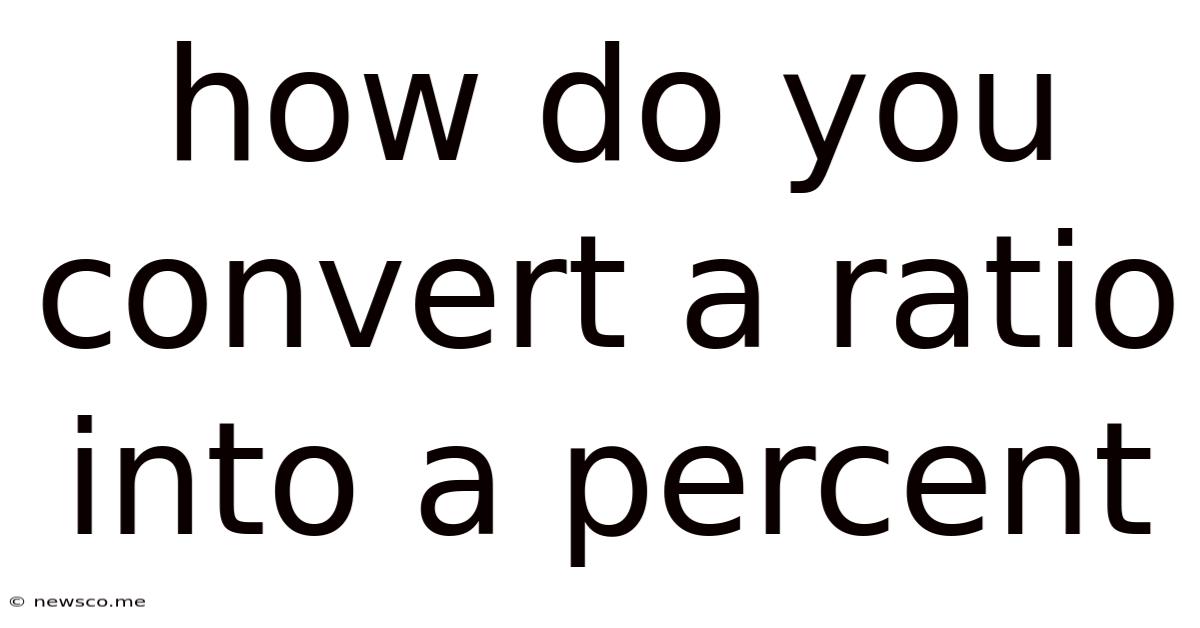How Do You Convert A Ratio Into A Percent
News Co
Apr 13, 2025 · 5 min read

Table of Contents
How Do You Convert a Ratio into a Percent? A Comprehensive Guide
Converting ratios to percentages is a fundamental skill with wide-ranging applications across various fields, from finance and statistics to everyday life. Understanding this conversion process empowers you to interpret data effectively, make informed decisions, and communicate information clearly. This comprehensive guide will walk you through the process step-by-step, covering different types of ratios and providing practical examples to solidify your understanding.
Understanding Ratios and Percentages
Before diving into the conversion process, let's clarify the definitions of ratios and percentages.
What is a Ratio?
A ratio is a mathematical comparison of two or more quantities. It shows the relative sizes of the quantities. Ratios can be expressed in several ways:
- Using the colon symbol: For example, the ratio of boys to girls in a class might be written as 3:2.
- Using the word "to": The same ratio can be expressed as "3 to 2".
- As a fraction: The ratio 3:2 can also be represented as 3/2.
What is a Percentage?
A percentage is a way of expressing a number as a fraction of 100. The symbol "%" represents "per cent," meaning "out of 100". For instance, 25% means 25 out of 100, or 25/100.
Converting Ratios to Percentages: A Step-by-Step Guide
The key to converting a ratio to a percentage is to first express the ratio as a fraction, then convert that fraction to a decimal, and finally, multiply the decimal by 100 to obtain the percentage.
Step 1: Express the Ratio as a Fraction
If your ratio is not already in fraction form, convert it. For example:
- Ratio: 3:5 becomes the fraction 3/5
- Ratio: 1 to 4 becomes the fraction 1/4
- Ratio: 2:1:3 (multiple quantities) - We'll explore this type of ratio conversion later.
Step 2: Convert the Fraction to a Decimal
To convert a fraction to a decimal, divide the numerator (the top number) by the denominator (the bottom number).
- For the fraction 3/5: 3 ÷ 5 = 0.6
- For the fraction 1/4: 1 ÷ 4 = 0.25
Step 3: Multiply the Decimal by 100 to Obtain the Percentage
The final step involves multiplying the decimal by 100 and adding the "%" symbol.
- For 0.6: 0.6 x 100 = 60%
- For 0.25: 0.25 x 100 = 25%
Therefore, the ratio 3:5 is equivalent to 60%, and the ratio 1:4 is equivalent to 25%.
Handling Different Types of Ratios
While the basic steps remain consistent, the approach might vary slightly depending on the type of ratio:
Converting Simple Ratios to Percentages
Simple ratios involve comparing two quantities. We've already covered this in the previous section.
Example: A team wins 7 out of 10 games. What is their win percentage?
- Ratio: 7:10 or 7/10
- Decimal: 7 ÷ 10 = 0.7
- Percentage: 0.7 x 100 = 70%
The team has a 70% win percentage.
Converting Ratios with More Than Two Quantities to Percentages
Ratios involving more than two quantities require a slightly different approach. You need to specify which part of the ratio you want to express as a percentage of the whole.
Example: A bag contains 2 red marbles, 3 blue marbles, and 5 green marbles. What percentage of the marbles are red?
- Total number of marbles: 2 + 3 + 5 = 10
- Ratio of red marbles to total marbles: 2/10
- Decimal: 2 ÷ 10 = 0.2
- Percentage: 0.2 x 100 = 20%
20% of the marbles in the bag are red.
Converting Ratios Expressed as Parts per Thousand or Million
Sometimes, ratios are expressed as parts per thousand (ppt) or parts per million (ppm), particularly in scientific contexts. The conversion to a percentage remains similar.
Example: A water sample contains 5 parts per thousand (ppt) of pollutants. What is the percentage of pollutants?
- Ratio: 5/1000
- Decimal: 5 ÷ 1000 = 0.005
- Percentage: 0.005 x 100 = 0.5%
The water sample contains 0.5% pollutants.
Real-World Applications of Ratio to Percentage Conversion
The ability to convert ratios to percentages is crucial in various real-world scenarios:
- Finance: Calculating interest rates, profit margins, and investment returns.
- Statistics: Analyzing survey data, representing proportions in graphs and charts, and interpreting probabilities.
- Science: Expressing concentrations of solutions, pollutant levels, and reaction yields.
- Everyday Life: Understanding discounts, calculating tips, and interpreting sports statistics.
Troubleshooting Common Errors
While converting ratios to percentages is relatively straightforward, some common mistakes can occur:
- Incorrect Fraction Formation: Ensure you correctly identify the numerator and denominator when converting the ratio into a fraction.
- Division Errors: Double-check your calculations when dividing the numerator by the denominator. Use a calculator if needed for accuracy.
- Misplacing the Decimal Point: Be mindful of the decimal point's position when multiplying the decimal by 100.
Conclusion: Mastering Ratio to Percentage Conversion
Converting ratios to percentages is a valuable skill with broad applicability. By understanding the fundamental steps and applying them consistently, you can confidently navigate various situations requiring this conversion. Remember to always double-check your work to minimize errors and ensure accuracy in your calculations. Mastering this skill empowers you to interpret data effectively and make informed decisions in various aspects of your personal and professional life. Practice regularly with diverse examples to build your confidence and fluency in this important mathematical process. From analyzing financial reports to understanding scientific data, this skill proves invaluable in a wide range of contexts.
Latest Posts
Related Post
Thank you for visiting our website which covers about How Do You Convert A Ratio Into A Percent . We hope the information provided has been useful to you. Feel free to contact us if you have any questions or need further assistance. See you next time and don't miss to bookmark.